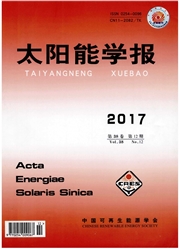

 中文摘要:
中文摘要:
研究了经典遗传算法在风力机叶片优化设计中的局部收敛和“进化停滞”问题,提出基于共享机制的自适应小生境技术的改进方法。应用_此算法,系统研究了不同光顺过程、设计目标和叶尖速比条件对1.5MW变桨恒频大型风力机叶片优化设计的影响。结果表明,采用先光顺后寻优的设计方法,能有效减小叶片质量和增大年发电量;以年发电量最大为目标设计的叶片虽然能少量提高年发电量,但是以提高风轮的整体实度为代价;在给定风场条件,年发电量随叶尖速比增大是一个先增后减的过程,由此可确定最佳叶尖速比。
 英文摘要:
英文摘要:
A novel genetic algorithm coupled with an adaptive, sharing and niche technology was developed for the optimization design of wind turbine blades to avoid the only local convergence and "evolutionary stagnation" which occur usually in simple genetic algorithm. This approach is then applied to design a series of 1.5MW variable speed pitch regulated wind turbine blades to investigate the effects of various smoothing procedures, various design targets and tip speed ratios. The results showed that smoothing prior to optimization can effectively reduce blade mass and increase annual energy production. When the annual energy production is taken as the optimization target, the blade design leads to a little increase in the energy production but at a cost of slightly higher blade solidity com- pared to the method of maximum power coefficient. In a given wind condition, the annual power production is first increased and then decreased with tip speed ratio increase. Therefore, the optimal tip speed ratio can be taken the value at which the maximum annual energy is produced.
 同期刊论文项目
同期刊论文项目
 同项目期刊论文
同项目期刊论文
 期刊信息
期刊信息
